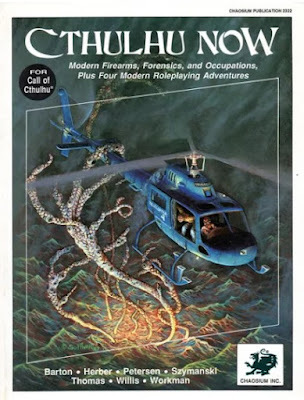Retrospective: Cthulhu Now
 Since its original release in 1981,
Call of Cthulhu
's default setting has been the 1920s. As a result, the venerable horror roleplaying game is inextricably linked to the Jazz Age in the minds of most gamers. This linkage is, however, a mere accident of history, a consequence of the fact that most of H.P. Lovecraft's tales, including the eponymous "The Call of Cthulhu," were written and published during that decade.
Since its original release in 1981,
Call of Cthulhu
's default setting has been the 1920s. As a result, the venerable horror roleplaying game is inextricably linked to the Jazz Age in the minds of most gamers. This linkage is, however, a mere accident of history, a consequence of the fact that most of H.P. Lovecraft's tales, including the eponymous "The Call of Cthulhu," were written and published during that decade. Of course, to Lovecraft and his readers, his stories of cosmic horror were set, not in the past, but in the present. Indeed, much of their power comes from the juxtaposition of ancient terrors and the perceived progress of the "modern world." On some level, it's thus always been a bit odd that Sandy Petersen Call of Cthulhu chose to retain the 1920s setting for the game rather than the here and now. Had he lived longer, I have little doubt that Lovecraft would have set his stories in whatever was the current date at the time, since that had (mostly) been his practice since he first took up writing.
At least some players of Call of Cthulhu agreed with this perspective, since, almost from the very beginning, I knew of those who'd set their campaigns in the then-present rather than the '20s. Indeed, within only a couple of years of the game's initial publication, White Dwarf magazine presented a two-part article by Marcus L. Rowland entitled "Cthulhu Now!". As I noted in my discussions of the issues in which it appeared, I adored Rowland's too-brief stab at the topic of updating Call of Cthulhu for the 1980s and readily made use of its rules expansions and additions. At the time, I thought a more contemporary setting made much more sense than the 1920s, which, in my gaming circle at least, we tended to associate with RPGs like Gangbusters.
So, when Chaosium published a new softcover rules supplement for Call of Cthulhu in 1987 with the title Cthulhu Now, I assumed that it was simply a further expansion of Rowland's original article and happily snapped it up from my local hobby shop without ever bothering to look inside its covers. When I did, I discovered that it was a similar but not entirely identical beast to that two-part White Dwarf offering of a few years prior. The name of Marcus Rowland was nowhere to be found. Instead, like so many Chaosium products of old, the book bore the bylines of no fewer than seven different authors, including Sandy Petersen himself. Over the years, I have long wondered why a book bearing an identical title (sans the exclamation point) and focusing on similar subjects doesn't even acknowledge Rowland's original. This is a gaming mystery that remains unsolved.
What's immediately noticeable about Chaosium's version of Cthulhu Now is that, of its 128 pages, less than a third are devoted to rules additions, alterations, or expansions – and more than a third of that is devoted to new equipment, particularly firearms. None this material is bad, let alone useless, but it feels rather beside the point. Of course the 1980s has lots of technology that didn't exist in the 1920s and it's important to provide game stats for the most significant examples of that technology. In my opinion, though, what really separates the present – whether the 1980s or the 2020s – from the 1920s, at least from the perspective of a Call of Cthulhu campaign, are social/cultural/political differences that would have an impact on how investigators might go about their business. We get a few nods in this direction, most notably in the form of a solid section on forensic pathology, but it's still not enough to aid the Keeper in setting his campaign in the modern era.
I suspect that Chaosium felt that the four scenarios Cthulhu Now includes would do a lot of the heavy lifting in this regard, providing practical examples of what a modern day CoC adventure might be like. As presented, the adventures contain a lot of good ideas and concepts, but they're often poorly implemented and verge on railroads at times – a common problem in Call of Cthulhu scenarios – so their utility as guides is limited. That said, they do show off the possibilities of contemporary gaming, ranging from an underwater investigation to dream research to space exploration and more. Admittedly, all four scenarios feel a bit dated now, largely because nearly four decades have passed since the book's publication and technology and society have continue to change.
Ultimately, though, I think my dissatisfaction with Cthulhu Now has more to do with my own ambivalence about setting Call of Cthulhu in the present day. As I stated earlier, this is something I've always felt made sense and that I instinctively wanted to do with the game. Yet, conversely, there's no denying that the Cthulhu Mythos, at least as its popularly conceived, has become almost quaint in its vision of cosmic horror, so quaint that it only really works well as a period piece. That's not to say that a contemporary approach to Lovecraftian horror is impossible, only that doing so effectively requires a lot more work and imagination than most people realize and Cthulhu Now is largely lacking in both.
James Maliszewski's Blog
- James Maliszewski's profile
- 3 followers



